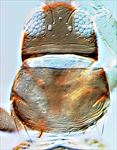
P. pediculae head & pronotum

P. pediculae antenna

P. pediculae head

P. pediculae prosternites
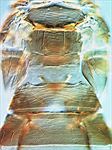
P. pediculae meso & metanota, and tergites I & II

P. pediculae tergites
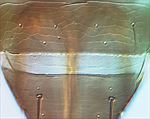
P. pediculae tergite VIII
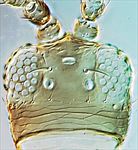
P. nadeshiko head
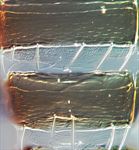
P. nadeshiko sternites VI-VII
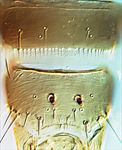
P. nadeshiko male tergites VIII-IX
Generic diagnosis
Female macropterous. Head slightly wider than long; maxillary palps 3-segmented; eyes large, often with five weakly pigmented facets; ocellar setae I present, setae III long; five pairs of postocular setae. Antennae 8-segmented, segment I with paired dorso-apical setae, III and IV with sense-cones forked, III–VI with microtrichial rows on both surfaces. Pronotum wider than long, with two pairs of long posteroangular setae, three to four pairs of posteromarginal setae. Mesonotum median pair of setae near to or far from posterior margin; campaniform sensilla present. Metanotum irregularly reticulate; median pair of setae at or near anterior margin; campaniform sensilla present or absent. Fore wing first vein with long gap in setal row, six to nine basal and two distal setae, second vein with setae equally spaced; clavus with five veinal setae and one discal setae. Prosternal ferna weakly connected medially, basantra membranous, without setae. Mesothoracic endofurca with spinula; sternopleural sutures complete; spinasternum broad and transverse. Metathoracic endofurca without spinula. Tarsi 2-segmented. Tergites without ctenidia or craspeda, median campaniform sensilla near posterior margin; tergite VIII often with a few irregular microtrichia anterolateral to spiracle, posteromarginal comb complete or present only laterally; IX with two pairs of campaniform sensilla; X with median split. Sternites without discal setae; III–VII with three pairs of posteromarginal setae, II with two pairs; laterotergites without discal setae.
Male similar to female but smaller; tergite IX with a pair of short stout setae medially; sternites III–VII with small scattered pore plates.
Biological data
Little is known about the biology of most species in this genus, but they probably all breed in flowers.
Distribution data
Amongst the 230 genera of Thripinae, the only generalisation about Pezothrips that is possible at present is that it is an Old World. Six species are known only from the area between southern Russia and Tibet, five species are from eastern Europe, and one species is from Japan (Masumoto & Okajima, 2019). One species is from eastern Australia (Nguyen et al., 2016) although introduced to southern Europe.
Nomenclatural data
Pezothrips Karny, 1907: 45. Type species Physopus frontalis Uzel 1895, by monotypy.
Yaothrips Mirab-balou et al., 2011: 47. Type species Y. shii Mirab-balou et al., by monotypy. Synonymised by Tong & Liu, 2019: 598.
This genus comprises 13 species (ThripsWiki, 2020), of which three are from China:
bactrianus (Pelikan, 1968: 219). (Taeniothrips)
brunicornis Mirab-balou & Tong, 2013: 349.
pediculae Han, 1988: 179. (Taeniothrips)
Relationship data
Thripidae sub-family Thripinae: this is a diverse group involving more than 230 genera. This genus is possibly polyphyletic. The included species all share with the species of Megalurothrips and Mycterothrips the presence of paired dorso-apical setae on the first antennal segment. Females of Pezothrips are distinguished from those of Ceratothripoides by the close placing of S1 setae on sternite VII, and males by the presence on tergite IX of a pair of stout setae medially. However, these character states do not apply to the citrus pest species, Pezothrips kellyanus, and this species is probably not closely related to P. frontalis (Masumoto & Okajima, 2019).
References
Masumoto M & Okajima S (2020) Two new species of Pezothrips (Thysanoptera, Thripidae) in Japan and Europe, with designation of lectotype of type species. Zootaxa 4743 (1): 075–091.
Mirab-balou M & Tong XL (2013) A new species and a new record of the genus Pezothrips Karny from China (Thysanoptera: Thripidae). Entomological News 122 (4): 348–353.
Nguyen DT, Spooner-Hart RN & Riegler M. (2016) Loss of Wolbachia but not Cardinium in the invasive range of the Australian thrips species, Pezothrips kellyanus. Biological Invasions 18: 197–214.
ThripsWiki (2020). ThripsWiki - providing information on the World's thrips. <http://thrips.info/wiki/Main_Page>